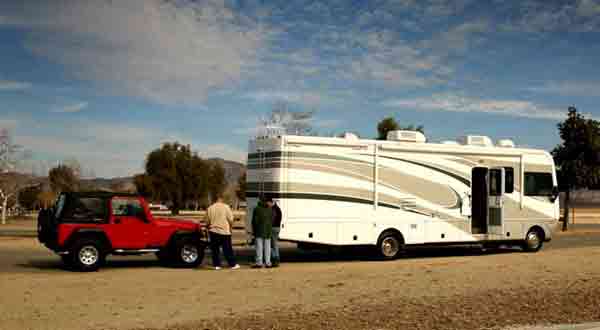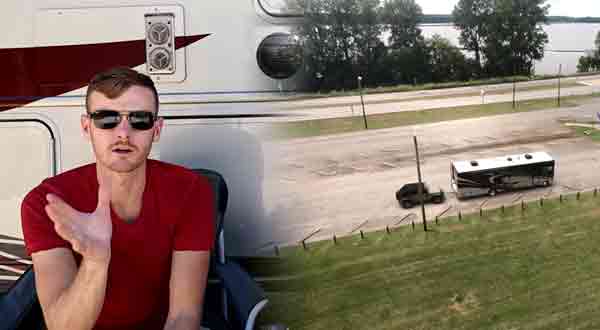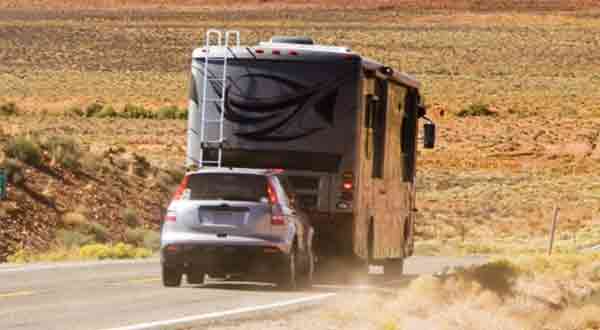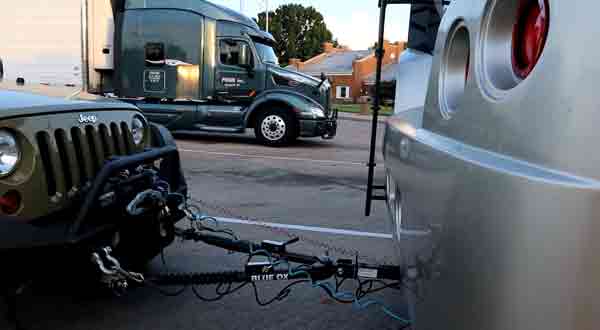Towing a car behind an RV may seem like a difficult task, but a lot of the complexities can be avoided if you take the appropriate approach. The first thing you have to do is make sure that you’ve got the right equipment to tow your car. Next you’ll need to apply the right techniques.
There are a several options but the following are the most common and practical: a tow dolly, a tow bar, an enclosed or flatbed trailer.
4 Ways About Towing A Car Behind An RV

1. Flatbed Or Enclosed Trailer
An enclosed or flatbed trailer provides you with a convenient way to tow behind large RVs and motorhomes. Both provide plenty of space for large off road vehicles, a good sized car or just extra space for your RV.
An enclosed or flatbed trailer comes with a light system, brakes, and the means to tow vehicles that a tow bar can’t handle. The drawback with either of these trailers is they cost more than a dolly or tow bar.
2. Use a tow bar
This enables you to tow a car behind your motorhome. It is a very common form of towing, with cables and chains used to stabilize the tow. You’ll also need to purchase lights and brakes so other vehicles will be alerted of your presence.
Tow bars are cost effective, but it is suitable for small cars only. Backing up is difficult or downright impossible, so make sure that the tow bar is appropriate for the vehicle you’re going to tow.
3. Use a tow dolly
A tow dolly tows your car behind your motorhome by putting the front wheels on the dolly and the rear wheels on the road. A tow dolly is useful if you don’t want to splurge on a flatbed or enclosed trailer, and also can’t tow your car with a tow bar.
A tow dolly is the cheapest of all towing options, but it is limited only to small vehicles. Most of them do come with electric brakes, surges or lights, but they’re not ideal for large vehicles.
4. Check Everything
Make sure the tow is suitable for your vehicle. Practice setting up the tow and using it before taking your RV and the vehicle out on the road. Check your vehicle’s weight to determine if the tow is capable of towing it.
4 RV Towing Purposes
1. For the first step, decide what kind of tow best fits your needs. As pointed out in the examples above, you’ve got to make certain the tow is appropriate for your vehicle. If you’re not sure, check your vehicle’s owner’s manual for the weight and other specs. That will tell you what you need.
2. It is important that you do not buy a vehicle to tow simply because you have seen other RVers towing it.
3. Before you buy a vehicle to tow four wheels down behind your RV, you should get your hands on a copy of its specific owners manual. Doing this ensures you’ll be able to to tow the vehicle without any problems.
4. Check the tow-ability of the vehicle and determine whether there is a base plate available for that specific model. This can’t be emphasized enough as some vehicles are very particular about how you’ll tow them.
15 RV Towing Tips

1. Transportation
Before you begin towing, measure the trailer’s weight and the tow’s weight rating. This is going to be important in determining what type of tow you’ll need.
2. Towing a Dinghy Behind A Motorhome
A dinghy means towing a vehicle with all four wheels on the ground. This is possible with certain types of tows and vehicles so you need to check if it’s suitable in your case.
3. RV Towing Guide
If you’re not sure on how to use a guide it is best to use a tow guide. There are a lot of resources available and it’s in your best interest to learn as much as you can to simplify the towing process.
4. Towing Behind a Motorhome Regulations
The rules for towing vary from state to state and country to country. If you’re going to tow your car in Ohio, look up the laws and regulations in that state as those in other states may not be applicable there.
5. Driving Safely With RV Towing Brakes
This is one thing that cannot be emphasized enough. Examine the brakes on your RV, and the vehicle you’re towing. This will literally make the difference between smooth driving and an accident.
6. RV & Tow Vehicle Weights
Keep your RV and vehicle manual handy as you’ll need it for calculating the trailer and vehicle weights.
7. Check the Towing Regularly
Once you’ve got your vehicle towed, check it every 50 miles to make sure all the connections are still intact.
8. Inspect Your RV Too

While the focus is on your towed vehicle, don’t forget to check your RV’s tires and other parts to make sure that everything is still working.
9. Take a Break
Driving an RV is hard work. Take a break every two hours or so and refresh yourself. Drop by a truck stop, grab something to eat and relax.
10. Check Everything Twice
Assess all the connections twice before leaving. Perform regular maintenance on your vehicle. This might seem like overkill but it is necessary to nip problems in the bud.
11. Dinghy Tow Safety
Do not allow passengers to ride on the dingy. It is too dangerous and in some locations this may be forbidden.
12. Towing Safely and Securely
So you’re towing along and then there is a breeze. Should that cause a problem? Well really it shouldn’t if the vehicle was towed properly. That is the reason why it’s imperative you ensure distribution and weights are accurate.
Take a look at the configuration options in your tow, as there will be settings that will prevent swaying. The options vary so you have to check the operating manual. Most of them have a weight distribution hitch mechanism, ideal for large vehicles.
If you do experience wind gust or a draft from another vehicle passing by, slowly lower your speed and keep the steering wheel steady. If necessary put on the brakes if the gust is really strong.
Never steer away from the gust and don’t try to speed past it. Do not make sudden turns and moves either. Doing any of those things will cause more problems.
13. Calculate and Do the Math
We already mentioned the numbers you need to figure out so no need to repeat them here. However there are certain things that need to be stressed here.
- Get an accurate figure of the total weight when loaded. When calculating weights be sure to include full fuel tanks, passengers and other items.
- Know the gross axle weight rating.
- Make certain the pressure on the tires are accurate.
- Get accurate measurements of the wheel position load.
- The center of gravity needs to be low for stability reasons.
- Double check the cargo to ensure they’re secure.
- The weight distribution needs to be accurate for the front, back, right and left have to be accurate.
- For 5,000 lb and over trailers it’s best to get a weight distribution system.
14. Other Factors To Consider

If you’re going to use a tow bar, make certain that it is capable of handling the load. You’ll also need to consider the tow capacity, and its durability. You’ll also have to look into the quality of the connectors, cables and other aspects.
If this is your first time to use a tow, practice hooking and unhooking it before taking it out on the road.
You also have to consider the compatibility of your RV, the tow and the vehicle being towed. You’ll need to be certain the two can function efficiently together. Do keep in mind that in some states a braking mechanism needs to be installed separately. This is often the case with towed vehicles that weigh more than 1500 lbs.
But apart from legal reasons, a dedicated brake system provides more safety options. Lighting is also mandatory as well as mirrors, so make certain that you’ve got sufficient mirrors on your RV and that they are properly placed. Extendable mirrors are even better so you won’t be caught unaware of traffic.
A rear vision camera may also be useful along with a monitor. Together these two may help you when changing lanes or backing up.
15. Practice Driving
Driving an RV can be difficult for the first timer especially if you have never driven anything bigger than a car, and adding a towed vehicle means more weight. Spend some time practicing driving with the towed vehicle so you can get accustomed to it.
As should be obvious by now, there is no single best way to tow a car behind an RV. Some may prefer a tow bar, dolly or an enclosed trailer. Only you can determine which one is suitable for your motorhome and vehicle.
That makes sense that you want to get an axle that can stand up to strong winds. My brother’s trailer flipped on the freeway because his connection was loose. I’ll have to get him a new trailer with a stronger hitch.
ok sure. And please also tell him to keep things safe.